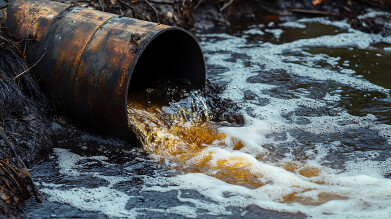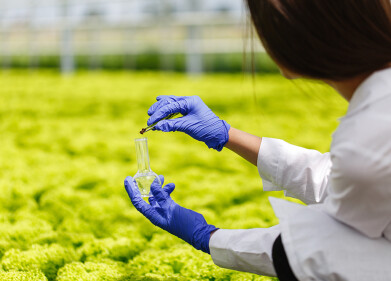PFAS analysis
How sewage sludge in agriculture contaminates crops with PFAS
Sep 25 2024
Per- and polyfluoroalkyl substances (PFAS), commonly referred to as "forever chemicals," have garnered widespread attention due to their persistence in the environment and potential to harm human health. PFAS are synthetic chemicals found in everyday products such as nonstick cookware, firefighting foam, and food packaging. Unfortunately, their ubiquity in modern society means that these chemicals eventually find their way into municipal wastewater systems, contributing to contamination in an unexpected area: agriculture. One major pathway for PFAS entry into cropland is through the use of sewage sludge as fertilizer, a practice that has sparked concern among scientists and farmers alike.
Sewage sludge, also known as biosolids, is the byproduct of wastewater treatment processes. After wastewater from homes, factories, and businesses is treated, the leftover solid material is often repurposed as fertilizer due to its nutrient-rich content. Farmers have been encouraged by the U.S. government to use sewage sludge on their fields for decades. It contains beneficial nutrients such as nitrogen, phosphorus, and potassium, which promote plant growth. Additionally, using biosolids reduces the need for synthetic fertilizers and keeps large quantities of sludge out of landfills.
However, while sewage sludge is a practical solution for nutrient recycling, it also carries the risk of chemical contamination, including PFAS. These contaminants are introduced into wastewater streams from various sources such as industrial discharges, consumer products, and household waste. During wastewater treatment, PFAS are not removed but instead accumulate in the sludge, which is then applied to farmlands.
PFAS enter municipal wastewater systems from a wide range of sources. These chemicals are used in many industries, including manufacturing nonstick cookware, water-repellent fabrics, firefighting foam, and food packaging. PFAS are highly resistant to breakdown, and once they enter the environment, they persist for years—hence the moniker "forever chemicals." When products containing PFAS are disposed of or washed away, the chemicals flow into sewage treatment plants.
Conventional wastewater treatment facilities are not equipped to filter out PFAS, allowing the chemicals to accumulate in the solid waste—sewage sludge. This sludge, when used as fertilizer, introduces PFAS into the soil. From there, the chemicals can be absorbed by crops, making their way into the food chain, or contaminate water sources that feed into nearby ecosystems.
Once sewage sludge is applied to agricultural land, the PFAS within it may begin transferring to the crops grown in that soil. Research has demonstrated that certain crops can absorb PFAS through their roots, introducing these harmful chemicals into food intended for human consumption. Additionally, livestock raised on land treated with contaminated sludge may ingest PFAS through the grass or feed grown in such soils, further spreading the contamination. This chain of transfer is concerning because of the potential health risks PFAS pose, including increased risk of cancer, developmental issues, and immune system suppression.
The extent of this contamination is staggering. It is estimated that about 20 million acres of U.S. cropland have been exposed to PFAS due to the use of biosolids. This is just under 5% of all U.S. farmland, but it includes a significant portion of the country’s agricultural output. The presence of PFAS on this scale highlights the need for more stringent regulations and more thorough monitoring of biosolid use in agriculture.
Despite the known risks of PFAS, regulations surrounding their presence in sewage sludge remain insufficient. The Environmental Protection Agency (EPA) regulates pathogens and heavy metals in biosolids but does not yet have specific standards for PFAS, although research has repeatedly shown that these chemicals are present in sewage sludge used on cropland. This lack of regulation has led to legal battles between affected farmers and both biosolid producers and regulatory bodies like the EPA.
Farmers in states like Texas, Michigan, and Maine have seen firsthand the devastating effects of PFAS contamination. In Texas, ranchers have filed lawsuits against companies that supplied contaminated sludge, accusing them of poisoning their livestock and water sources. Meanwhile, in Maine, the state has taken decisive action by banning the use of sewage sludge as fertilizer altogether. Maine also became the first state to systematically test farms for PFAS contamination, finding evidence of contamination on dozens of farms with potentially thousands more awaiting testing.
As awareness of PFAS contamination grows, the future of sewage sludge as a fertilizer is increasingly uncertain. While some states have begun addressing the issue, the widespread use of biosolids across the country makes it a complex problem to tackle. Banning sludge fertilizers outright, as Maine has done, presents its own set of challenges, including where to dispose of the millions of tons of sludge generated each year.
A more promising solution may lie in tackling the problem at its source—reducing or eliminating the use of PFAS in consumer and industrial products. By stopping these chemicals from entering wastewater systems in the first place, the need for costly remediation could be minimized. In the meantime, stricter regulations and improved testing protocols for biosolids are essential to protect both farmers and the food supply from further contamination.
Digital Edition
IET 35.2 March
April 2025
Air Monitoring - Probe Sampling in Hazardous Areas Under Extreme Conditions - New, Game-Changing Sensor for Methane Emissions - Blue Sky Thinking: a 50-year Retrospective on Technological Prog...
View all digital editions
Events
Apr 29 2025 Edmonton, AB, Canada
May 06 2025 Nuremberg, Germany
May 10 2025 Karachi, Pakistan
May 11 2025 Vienna, Austria
May 11 2025 Seoul, South Korea













_(4427399123)-(2).jpg)





